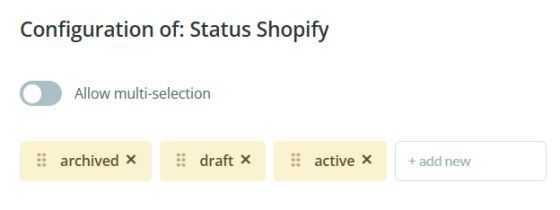Status and visibility
Collections
Collections in Shopify do not have a status, but they do have visibility. Therefore, when excluding them from a synchronization, their visibility will behave as described in Parameters. In addition, to manage their availability in different sales channels, the published_scope field can be used.
Products
Shopify has three possible status for products:
- active: the product is ready to be sold in the store.
- archived: the product is no longer for sale.
- draft: the product is not ready for sale.
However, depending on the configuration mentioned in Parameters, when selecting to export items with the status All (visible, draft, invisible), the products will be synchronized as active regardless of their status in Sales Layer.
This behavior can be modified by mapping the Status field from Sales Layer with the default Status field created in the connector. In this way, the visible status in Sales Layer will be synchronized as active, draft as draft, and invisible as archived in Shopify.
![]()
If the product status sent to Shopify need to be managed differently from the status used in Sales Layer, a second field can be created within the product form specifically for this purpose, for example named Status Shopify. This field would be mapped with the default Status field in the connector, to handle the sending of items according to the specific status designated for that connector.
The following example of Status Shopify works with a list of attributes field with multi-, whose options are active, draft, and archived. The same values must be used if working with a short text field instead of using a list.


Once configured, it can be mapped in the connector.
Variants
Variants in Shopify do not have a status, and therefore cannot be archived or set to draft.
If the connector’s visibility filter (in Parameters) is configured to export All status, all variants will be created as active, regardless of their status in Sales Layer.
If you want to manage this differently while still sending all status, the Status field in Variants can be mapped. The connector would interpret the status sent as follows:
- V (Visible) → create or update the variant
- D (Draft) → delete the variant
- I (Invisible) → delete the variant
On the other hand, it is important to take into account the behavior of Shopify’s internal IDs. When variants are excluded from a synchronization as described in Parameters, the variants will be deleted and then recreated (for example, changing their status back to visible). Therefore, the new Shopify ID will not be the same as before.